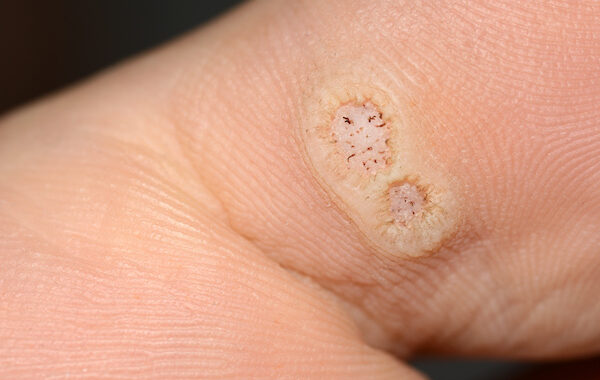Plantar warts or verrucas are localized thickenings that appear on the soles of the feet (the ‘plantar’ surface) or other weight-bearing areas. Plantar warts range in size from a few millimeters to over a centimeter. They may have a rough and grainy surface that protrudes from the surface of the skin (lesion). Small black spots (wart seeds) may be visible with a magnifying glass under close observation.
Causes
Warts are caused by a virus called the human papillomavirus or HPV infecting the outer layer of the skin (epidermis), usually at the base of the toes and forefoot or the heel. There are numerous strains of this virus, yet plantar warts are typically caused by only a handful of them. The infection causes the skin to thicken and overgrow, resulting in benign (non-cancerous) skin growth (the wart). The virus enters the skin through tiny cuts, breaks, or other weak spots on the surface of the skin. The moistness and maceration of the skin on the feet likely facilitate virus infection.
Diagnosis
The clinical appearance is usually used to make a diagnosis. It can be difficult to distinguish between a plantar wart and corn. Your doctor may need to reduce the size of the affected area to find the dark spots that confirm the diagnosis of an infectious wart. Other examinations are rarely required.
Treatment
Most plantar warts can be treated with over-the-counter topical medications and a consultation from your pharmacist. Your doctor may need to prescribe treatments at times.
You should visit a doctor if:
- The lesion is bleeding, inflammatory, or changing in appearance.
- Interfering with your everyday activities.
- You are unsure about the diagnosis.
- You treated the wart, but it persisted and began to spread.
- You have diabetes or have a weak foot sensation.
- You have a compromised immune system due to immunosuppressive medicines, AIDS, or an immune-deficiency illness.
Treatment options for plantar warts include:
No treatment
Most plantar warts disappear on their own within two years of first appearing. Plantar warts that do not cause any severe symptoms, such as unbearable pain, should be left alone.
Salicylic acid paints and gels
Salicylic acid works by exfoliating the skin’s outer dead layers and stimulating the immune system to expel the infection. Before going this topical route, soak the feet in warm water and file away any thickened skin with a pumice stone or emery board.
To avoid spreading the virus, take care not to scrape the surrounding normal skin. Treatment should be administered regularly for at least 12 weeks and is usually most convenient after bedtime. The paint/gel should only be administered to the wart and not the surrounding normal skin. If the wart gets excessively sore, treatment should be paused for a few days before restarting.
Cryotherapy
Liquid nitrogen may be used to freeze warts at your doctor’s or podiatrist’s office. To allow the cold to penetrate the skin, thick warts must be removed before freezing. Cryotherapy should ideally be performed every three to four weeks.
It may take several freezes to clear warts, and it may not always work. Using a salicylic acid treatment in between freezes may boost efficacy.
Duct Tape
Although there is mixed evidence regarding the usefulness of duct tape in treating plantar warts, it may be worth a try, especially among children.
Duct tape should be used to cover the wart for six days, and if the tape comes off, it should be replaced with a new piece. After removing the tape, the affected area should be soaked in lukewarm water, and the wart should be pared down to clear any dead cells.
The wart should then be left uncovered overnight before reapplying the duct tape in the morning. This can be done for a period of up to two months.
If these treatment options do not work, you can consider surgical removal.
Additional Tips
- Wear well-fitting shoes, and do not share your socks or shoes with anyone else. You may also want to get special pads to reduce pressure on plantar warts.
- Maintain clean and dry feet.
- Change your shoes and socks daily.
- When treating the wart, dispose of any skin filings in a sanitary manner and avoid using the emery board or hard skin removal tools elsewhere, as this may spread the infection.
- To increase your chances of success, use topical treatments regularly.
- Do not pick or scratch plantar warts to avoid spreading viral warts to other parts of the skin (autoinoculation).
- Use a different pumice stone, nail file, or nail clippers for warts and healthy skin and nails.
Visit the FootDocStore.com blog for more information on how to keep your feet and ankles healthy.

